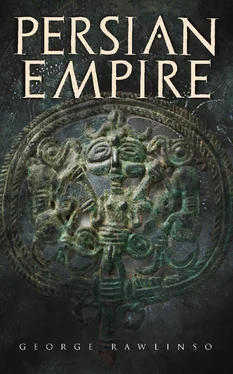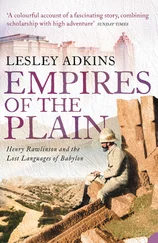George Rawlinson - Persian Empire
Здесь есть возможность читать онлайн «George Rawlinson - Persian Empire» — ознакомительный отрывок электронной книги совершенно бесплатно, а после прочтения отрывка купить полную версию. В некоторых случаях можно слушать аудио, скачать через торрент в формате fb2 и присутствует краткое содержание. Жанр: unrecognised, на английском языке. Описание произведения, (предисловие) а так же отзывы посетителей доступны на портале библиотеки ЛибКат.
- Название:Persian Empire
- Автор:
- Жанр:
- Год:неизвестен
- ISBN:нет данных
- Рейтинг книги:3 / 5. Голосов: 1
-
Избранное:Добавить в избранное
- Отзывы:
-
Ваша оценка:
- 60
- 1
- 2
- 3
- 4
- 5
Persian Empire: краткое содержание, описание и аннотация
Предлагаем к чтению аннотацию, описание, краткое содержание или предисловие (зависит от того, что написал сам автор книги «Persian Empire»). Если вы не нашли необходимую информацию о книге — напишите в комментариях, мы постараемся отыскать её.
Contents:
Extent of the Empire.
Climate and Productions.
Character, Manners and Customs.
Language and Writing.
Architecture and Other Arts.
Religion.
Chronology and History.
Persian Empire — читать онлайн ознакомительный отрывок
Ниже представлен текст книги, разбитый по страницам. Система сохранения места последней прочитанной страницы, позволяет с удобством читать онлайн бесплатно книгу «Persian Empire», без необходимости каждый раз заново искать на чём Вы остановились. Поставьте закладку, и сможете в любой момент перейти на страницу, на которой закончили чтение.
Интервал:
Закладка:
Such was the geographical extent of the Persian Empire, and such were the chief provinces which it contained besides those previously comprised in the empires of Media or Babylon. Territorially, the great mass of the Empire lay towards the east, between long. 50° and 75°, or between the Zagros range and the Indian Desert. But its most important provinces were the western ones. East of Persepolis, the only regions of much value were the valleys of the Indus and the Oxus. Westward lay Susiana, Babylonia, Assyria, Media, Armenia, Iberia, Cappadocia, Asia Minor, Cyprus, Syria, Palestine, Egypt, the Cyrenaica—all countries of great, or at least considerable, productiveness. The two richest grain tracts of the ancient world, the best pasture regions, the districts which produced the most valuable horses, the most abundant of known gold-fields, were included within the limits of the Empire, which may be looked upon as self-sufficing, containing within it all that man in those days required, not only for his necessities, but even for his most cherished luxuries.
The productiveness of the Empire was the natural result of its possessing so many and such large rivers. Six streams of the first class, having courses exceeding a thousand miles in length, helped to fertilize the lands which owned the sway of the Great King. These were the Nile, the Indus, the Euphrates, the Jaxartes, the Oxus, and the Tigris. Two of the six have been already described in these volumes, and therefore will not need to detain us here; but a few words must be said with respect to each of the remaining four, if our sketch of the geography of the Empire is to make any approach to completeness.
The Nile was only in the latter part of its course a Persian stream. Flowing, as we now know that it does, from within a short distance of the equator, it had accomplished more than three fourths of its course before it entered a Persian province. It ran, however, through Persian territory a distance of about six hundred miles, and conferred on the tract through which it passed immeasurable benefits. The Greeks sometimes maintained that “Egypt was the gift of the river;” and, though this was very far from being a correct statement in the sense intended, there is a meaning of the words in which we may accept them as expressing a fact. Egypt is only what she is through her river. The Nile gives her all that makes her valuable. This broad, ample, and unfailing stream not only by its annual inundation enriches the soil and prepares it for tillage in a manner that renders only the lightest further labor necessary, but serves as a reservoir from which inexhaustible supplies of the precious fluid can be obtained throughout the whole of the year. The water, which rises towards the end of June, begins to subside early in October, and for half the year—from December till June—Egypt is only cultivable through irrigation. She produces, however, during this period, excellent crops—even at the present day, when there are few canals—from the facility with which water is obtained, by means of a very simple engine, out of the channel of the Nile. This unfailing supply enabled the cultivator to obtain a second, a third, and even sometimes a fourth crop from the same land within the space of a year.
The course of the Nile from Elephantine, where it entered Egypt, to Cercasorus, near Heliopolis, where it bifurcated, was in general north, with, however, a certain tendency westward. It entered Egypt nearly in long. 33°, and at Neapolis (more than two degrees further north) it was still within 15° of the same meridian; then, however, it took a westerly bend, crossed the 32nd and 31st meridians, and in lat. 28° 23 reached west as far as long. 30° 43’. After this it returned a little eastward, recrossed the 31st meridian, and having reached long. 31° 22’ near Aphroditopolis (lat.29° 25), it proceeded almost due north to Cercasorus in lat. 30° 7’. The course of the river up to this point was, from its entry into the country, about 540 miles. At Cercasorus the Delta began. The river threw out two branches, which flowed respectively to the north-east and the north-west, while between them was a third channel, a continuation of the previous course of the stream, which pierced the Delta through its centre, flowing almost due north. Lower down, further branch channels were thrown out, some natural, some artificial, and the triangular tract between the two outer arms of the river was intersected by at least five, and (in later times) by fourteen large streams. The right and left arms appear to have been of about equal in length, and may be estimated at 150 or 160 miles; the central arm had a shorter course, not exceeding 110 miles. The volume of water which the Nile pours into the Mediterranean during a day and night is estimated at from 150,000 millions to 700,000 millions of cubic metres. It was by far the largest of all the rivers of the Empire.
The Indus, which was the next largest of the Persian rivers to the Nile, rose (like the Nile) outside the Persian territory. Its source is in the region north of the Himalaya range, about lat. 31°, long. 82° 30’. It begins by flowing to the north-west, in a direction parallel to that of the Western Himalayas, along the northern flank of which it continues in this line a distance of about 700 miles, past Ladak, to long. 75° nearly. Here it is met by the Bolor chain, which prevents its further progress in this direction and causes it to turn suddenly nearly at a right angle to the south-west. Entering a transverse valley, it finds a way (which is still very imperfectly known) through the numerous ridges of the Himalaya to the plain at its southern base, on which it debouches about thirty miles above Attock. It is difficult to say at what exact point it crossed the Persian frontier, but probably at least the first 700 miles of its course were through territory not Persian. From Attock to the sea the Indus is a noble river. It runs for 900 miles in a general direction of S.S.W. through the plain in one main stream (which is several hundred yards in width), while on its way it throws off also from time to time small side streamlets, which are either consumed in irrigation or rejoin the main channel. A little below Tatta its Delta begins—a Delta, however, much inferior in size to that of the Nile. The distance from the apex to the sea is not more than sixty miles, and the breadth of the tract embraced between the two arms does not exceed seventy miles. The entire course of the Indus is reckoned at 1960 miles, of which probably 1260 were through Persian territory. The volume of the stream is always considerable, while in the rainy season it is very great. The Indus is said then to discharge into the Indian ocean 446,000 cubic feet per second, or 4280 millions of cubic yards in the twenty-four hours.
The Oxus rises from an Alpine lake, lying on the western side of the Bolor chain in lat. 37° 40’, long. 73° 50’. After a rapid descent from the high elevation of the lake, during which it pursues a somewhat serpentine course, it debouches from the hills upon the plain about long. 69° 20’, after receiving the river of Fyzabad, and then proceeds, first west and afterwards north-west, across the Great Kharesmian Desert to the Sea of Aral. During the first 450 miles of its course, while it runs among the hills, it receives from both sides numerous and important tributaries; but from the meridian of Balkh those fail entirely, and for above 800 miles the Oxus pursues its solitary way, unaugmented by a single affluent, across the waste of Tartary, rolling through the desert a wealth of waters, which must diminish, but which does not seem very sensibly to diminish, by evaporation. At Kilef, sixty miles north-west of Balkh, the width of the river is 350 yards; at Khodja Salih, thirty miles lower down, it is 823 yards with a depth of twenty feet; at Kerki, seventy miles below Khodja Salih, it is “twice the width of the Danube at Buda-Pesth,” or about 940 yards; at Betik, on the route between Bokhara and Merv, its width has diminished to 650 yards, but its depth has increased to twenty-nine feet. Finally, at Gorlen Hezaresp near Khiva, the breadth of the Oxus is so great that both banks are hardly distinguishable at the same time; but the stream is here comparatively shallow, ceasing to be navigable at about this point. The present course of the Oxus from its rise in Lake Sir-i-Kol to its termination in the Sea of Aral is estimated at 1400 miles. Anciently its course must have been still longer. The Oxus, in the time of the Achaemenian kings, fell into the Caspian by a channel which can even now be traced. Its length was thus increased by at least 450 miles, and, exceeding that of the Jaxartes, fell but little short of the length of the Indus.
Читать дальшеИнтервал:
Закладка:
Похожие книги на «Persian Empire»
Представляем Вашему вниманию похожие книги на «Persian Empire» списком для выбора. Мы отобрали схожую по названию и смыслу литературу в надежде предоставить читателям больше вариантов отыскать новые, интересные, ещё непрочитанные произведения.
Обсуждение, отзывы о книге «Persian Empire» и просто собственные мнения читателей. Оставьте ваши комментарии, напишите, что Вы думаете о произведении, его смысле или главных героях. Укажите что конкретно понравилось, а что нет, и почему Вы так считаете.












